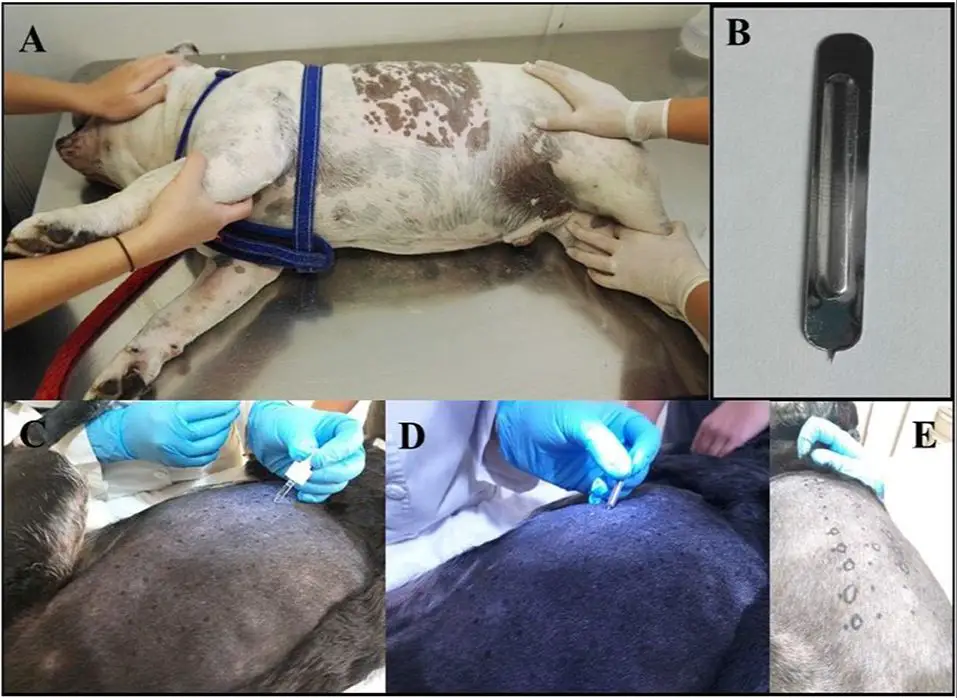Introduction
Allergies are common in dogs, with studies estimating that 10-15% of the canine population suffers from some form of allergy. Allergies occur when the immune system overreacts to something in the environment that is normally harmless. This overreaction leads to an inflammatory response that causes the bothersome symptoms we associate with allergies. Some of the most common allergy triggers in dogs include pollen, mold, dust mites, flea saliva, and certain proteins in food.
Dogs can develop allergies at any age, though they often first appear when dogs are young adults between 1-3 years old. Certain breeds like Labradors, Golden Retrievers, and German Shepherds tend to be more prone to allergies. Allergies can significantly impact a dog’s quality of life, so it’s important for pet owners to recognize the signs and work with their veterinarian to accurately diagnose the cause and find an effective treatment plan.
Common Allergy Symptoms
Some of the most common allergy symptoms that dogs exhibit include:
-
Itchy skin – Dogs with allergies may excessively lick, scratch, or chew at their skin, leading to redness, hair loss, and skin infections.
-
Ear infections – Allergies can cause inflammation and bacterial/yeast infections in a dog’s ears.
-
Hair loss – Dogs may lick, scratch, or rub themselves so much that they damage their skin and coat, resulting in bald spots or thinning fur.
-
Chewing/licking – Dogs may compulsively lick their paws, tails, or other areas to soothe itchy skin caused by allergies.

If a dog is displaying any of these allergy symptoms frequently or chronically, it’s a sign they may have an underlying allergy issue that requires veterinary attention.
Diagnostic Tests
There are several ways a veterinarian can test a dog for allergies and determine what the dog may be allergic to. Common diagnostic tests include:
Intradermal Testing
Intradermal allergy testing, also known as skin testing, involves injecting small amounts of suspected allergens like pollen or dander just under the surface of the dog’s skin. A vet will then check for a reaction such as redness or swelling at the injection site, which indicates an allergy. Intradermal testing is considered one of the most accurate ways to diagnose allergies in dogs.
Blood Testing
A veterinarian may also run a blood test to check for the presence of allergen-specific antibodies. A high level of antibodies against a particular allergen indicates the dog may be allergic. While not quite as precise as intradermal testing, blood tests can be useful for identifying the causes of allergies.
Elimination Diets
Putting a dog on an elimination diet, where its regular food is switched out for a novel protein and carbohydrate source like venison and sweet potatoes, can help determine food allergies. If allergy symptoms improve on the elimination diet, a vet can then reintroduce ingredients one at a time to pinpoint the problem foods.
Intradermal Testing
One of the most common allergy tests for dogs is intradermal testing. This test involves injecting small amounts of suspected allergens just under your dog’s skin and checking for reactions.
During intradermal testing, your vet will first shave a small patch of your dog’s fur to expose the skin. Next, they will use a needle to inject tiny amounts of extracts made from common allergens. These allergens may include pollens, dust mites, molds, and proteins from foods.

After each injection, your vet will check for an allergic reaction. Signs of a reaction include redness, swelling, and itching at the injection site. Reactions typically occur within 15-20 minutes if your dog is allergic to that substance.
Intradermal allergy testing allows vets to pinpoint exactly which allergens trigger an IgE-mediated allergic response in your dog. This helps guide treatment recommendations like allergen avoidance, medications, or immunotherapy.
Blood Testing
A blood test can check for allergen-specific antibodies known as IgE antibodies. This test is done by taking a small blood sample from the dog and sending it to a veterinary diagnostic lab for analysis. The lab will check the blood serum for elevated levels of IgE directed against certain allergens.
If the IgE level for a particular allergen is higher than normal, it indicates the dog’s immune system is reacting to that allergen. This can help identify substances like pollen, dust mites, molds, and proteins in food that could be causing an allergic response or sensitivity in the dog.
Blood tests provide quantitative results, meaning they can measure the actual amount of IgE antibodies present against each allergen tested. This helps vets determine which allergens are provoking the strongest immune system reaction in that individual dog.
Unlike intradermal skin testing, blood tests do not require stopping antihistamines or steroid medications. However, blood testing can be more expensive than skin testing and results may take longer. False positives and negatives are also possible. Still, checking blood levels of allergen-specific IgE antibodies is an important diagnostic tool for identifying allergies in dogs.
Elimination Diets
One of the main methods vets use to diagnose food allergies in dogs is through elimination diets. This involves removing any suspected allergenic ingredients from the dog’s diet for a period of weeks or months to see if symptoms improve.
Common food allergens for dogs include beef, chicken, dairy, wheat, corn, soy, lamb, and eggs. Elimination diets start by feeding the dog a novel protein and carbohydrate source, something they haven’t eaten before, such as venison and potato. Over time, ingredients are reintroduced one at a time while monitoring for reactions.
If symptoms disappear on the elimination diet but return when certain foods are reintroduced, those can be identified as allergens. Elimination diets require patience and commitment from the owner to strictly follow the diet, but can provide valuable information to diagnose and manage food allergies.
Allergen Avoidance
One of the most effective ways to manage allergies in dogs is to avoid exposure to the allergens that trigger reactions. This requires identifying the specific allergens through diagnostic testing methods like intradermal skin testing or blood tests. Once the allergens are identified, pet owners can take steps to reduce their dog’s contact with those triggers.

For environmental allergens like pollen, mold, or dust mites, this may involve keeping the dog indoors during peak allergy seasons, using air filters and vacuums with HEPA filters, washing bedding frequently in hot water, and using allergen-proof covers for bedding. It’s also important to bathe dogs regularly to remove allergens from their coats.
For food allergies, an elimination diet trial is used to identify problem ingredients. Once identified, those food proteins must be strictly avoided. This may require feeding a hypoallergenic or novel protein diet long-term. Reading pet food labels carefully and avoiding treats with problem ingredients is key.
While allergen avoidance can be challenging, it is typically an essential component of managing allergies in dogs alongside medications and immunotherapy. Diligence from pet owners combined with veterinary guidance can help significantly reduce allergic reactions.
Medications
Medications can help provide relief for dogs suffering from allergies. Some common medications prescribed by vets include:
Antihistamines – Antihistamines like diphenhydramine (Benadryl) and hydroxyzine can help block the effects of histamine, reducing itchiness and inflammation. They provide short-term relief but often need to be given frequently.
Steroids – Steroids like prednisone and dexamethasone help control inflammation and immune system responses. They are very effective at relieving allergy symptoms but can have significant side effects with long-term use.
Other drugs – Vets may prescribe other drugs aimed at specific symptoms, like Atopica to modulate immune responses or antibiotics if secondary skin infections develop. Pain relievers may also help with discomfort from inflammation and itching.
Medications can provide rapid relief from allergy symptoms while identifying and avoiding the allergen. However, medications alone don’t represent a permanent solution, as they don’t address the underlying cause of the allergies.
Immunotherapy
Immunotherapy, also known as allergy shots, is a form of treatment that aims to desensitize the immune system to specific allergens. It works by administering increasing doses of allergens through injections over several months to years. The goal is to increase the patient’s tolerance and reduce immune system overreaction to allergens.
With immunotherapy, very small amounts of an allergen are injected, with gradually increasing doses over time. This process conditions the immune system to become less sensitive to the allergen. It’s one of the only allergy treatments capable of modifying the immune system’s response. immunotherapy has been shown to induce long-term remission of allergy symptoms for many patients. It may even prevent the progression of allergic disease over time.

Immunotherapy is customized to each patient’s specific allergies. Allergens the patient reacts to are identified through testing. Custom allergy shot vials are then formulated containing just the allergens the patient is sensitive to. The starting doses in the vials are extremely low to avoid severe reactions.
Patients receive injections on a regular basis, starting with once or twice per week. The dosage is gradually increased over time. Maintenance doses are eventually reached, at which point injection frequency can be reduced to every 2-4 weeks. It generally takes 3-6 months to reach maintenance levels. Immunotherapy is continued for 3-5 years. After this period, benefits may persist for several years or even permanently.
Immunotherapy is most commonly used for airborne allergens such as pollen, dust mites, mold, and animal dander. It can significantly reduce allergy symptoms and the need for medication in many patients. It may also help prevent the development of asthma in some cases. Immunotherapy is an effective option for managing allergies long-term.
Conclusion
In conclusion, there are several ways veterinarians test dogs for allergies. The most common diagnostic methods include intradermal skin testing, blood testing for allergen-specific IgE antibodies, elimination diet trials, and allergen avoidance trials. Each test has its pros and cons. Intradermal testing is considered the gold standard but requires light sedation and is more invasive. Blood tests are minimally invasive but less accurate. Elimination diets temporarily remove allergens from the diet to identify problem foods. Avoidance trials remove environmental allergens to pinpoint issues. Often vets use a combination of testing methods to accurately diagnose canine allergies. The goal is to identify the specific allergens causing symptoms so they can be avoided or treated with medications like antihistamines or immunotherapy. While allergies can’t be cured, vets have effective ways to diagnose the triggers and manage symptoms to provide dogs relief and improved quality of life.